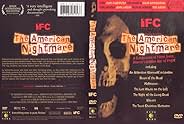Ajouter une intrigue dans votre langueAn examination into the nature of 1960s-'70s horror films, the artists involved, and how they reflected contemporary society.An examination into the nature of 1960s-'70s horror films, the artists involved, and how they reflected contemporary society.An examination into the nature of 1960s-'70s horror films, the artists involved, and how they reflected contemporary society.
- Self
- (as Carol Clover)
- Self
- (images d'archives)
- Self
- (images d'archives)
- Self
- (images d'archives)
- Elevator Mother
- (images d'archives)
- Self
- (images d'archives)
- Self
- (images d'archives)
- (as Bill 'Chilly Billy' Cardille)
- Self
- (images d'archives)
- Self
- (images d'archives)
Avis à la une
I was especially surprised to see how affected most of them were by the Vietnam war, like Tom Savini, who served in the war and now does horror movie makeup, witnessed horrible atrocities and awful, bloody deaths, and then went on to incorporate those things into his movies. Kind of morbid, really, to think that he was an American soldier who, by his own words, would see dead bodies and would just detach himself from the immediacy and finality of it, and instead think more about how he could recreate something like that in a movie. Until I saw this documentary, I never once considered the idea of trying to recreate war deaths, at least by a soldier who is standing right there.
Even directors who did not actually go to Vietnam were affected by the war, and it's amazing to see this powerful time in this country come across in what could easily be written off as just scary, gory horror movies. Good horror movies, but still nothing more than horror movies.
In some of the clips that were shown, such as scenes from one of Wes Craven's first films, The Last House on the Left, I was amazed at how intense the horror is. I've been watching a lot of horror movies lately, things like the Friday the 13th movies, Nightmare on Elm Streets, Halloween, Child's Play, Texas Chainsaw, etc, and have started to think that I had just outgrown that sick feeling of fear and almost nausea that I would get as a kid just from walking around in the horror section, like the real raw horror movies turned into campy gore-fests by the time I got to the age I am now, but man, I must be going to the wrong video stores.
There are some scenes shown in this movie that remind you what the real horror movies were like, back when they were meant to scare, not make tons of money. Back before the Japanese had to come in and show us how it's done, because we have obviously forgotten. Rob Zombie came out with House of 1000 Corpses last year, an underrated horror film that didn't set any box office records because it wasn't meant to. Like the directors in The American Nightmare, he is a lifelong horror fan and remembers what the real horror films were like. House of 1000 Corpses was his reminder to the world, now all these other directors are doing the same.
While I loved hearing the directors talk about their movies and I loved watching all of the clips from their films, all the while trying to compile a mental list of movies that I need to rent, I have to say that I found the legitimacy of these horror films in the context of the society in which they were created to be the most interesting part. You don't really think about horror movies having too much social value or meaning, but these movies, as they say, are clearly a product of their environment.
I found myself wondering at many points if we are going to see a new breed of horror directors eventually come home from Iraq
as i sat here watching american nightmare, i nodded and nodded as i remembered my childhood and the constant nightmares and fear of the end of the world, death, and the catholic theories of a fire and brimstone afterlife. the constant threat of atomic wars, hidden under our schoolchairs as we had air-raid drills. even when it was vacation time at school, the automatic drills echoed in the background once a month. i lived within walking distance and would often go to the schoolyard during vacation times to play there with others.
the most frightening sound in the world is not the screams of michael myers' victims or the ripping of zombie flesh, but the eerie sound of an air-raid sirien going off in a virtualy empty playground mixed with the squeak of swings, the wind, and the "ting" of the empty flag pole.....
Le saviez-vous
- AnecdotesPackaged as an extra on the Region 2 release of Wes Craven's The Hills Have Eyes (1977).
- Citations
Wes Craven: I think there is something about the "American Dream", the sort of Disneyesque dream if you will of the beautifully trimmed front lawn, the white picket fence, mom and dad and their happy children, god fearing and doing good whenever they can; that sort of expectation, and the flipside of it, the kind of anger and the sense of outrage that comes from discovering that that's not the truth of the matter, I think that gives American horror films in some ways kind of an additional rage...
- Versions alternativesDespite being shown uncut on BBC TV the version released in the UK, as part of The Hills Have Eyes 2-disc by Anchor Bay, was cut by 14 secs by the BBFC. This was to remove scenes from _Last House on the Left, The (1972)_ which had previously been cut by the BBFC.
- ConnexionsFeatures Dracula (1931)
Meilleurs choix
Détails
- Durée1 heure 13 minutes
- Couleur
- Mixage
- Rapport de forme
- 1.85 : 1
Contribuer à cette page

















